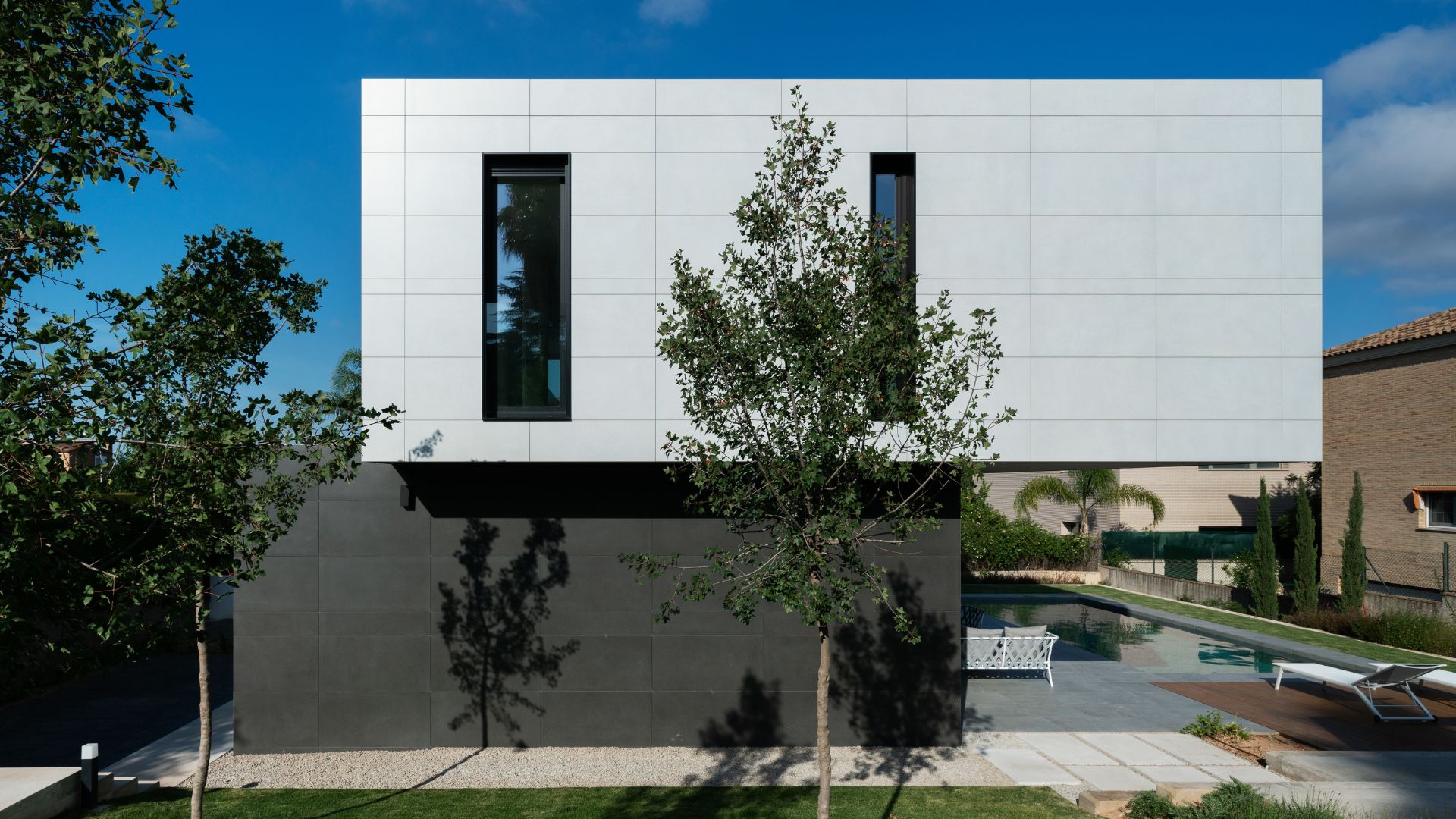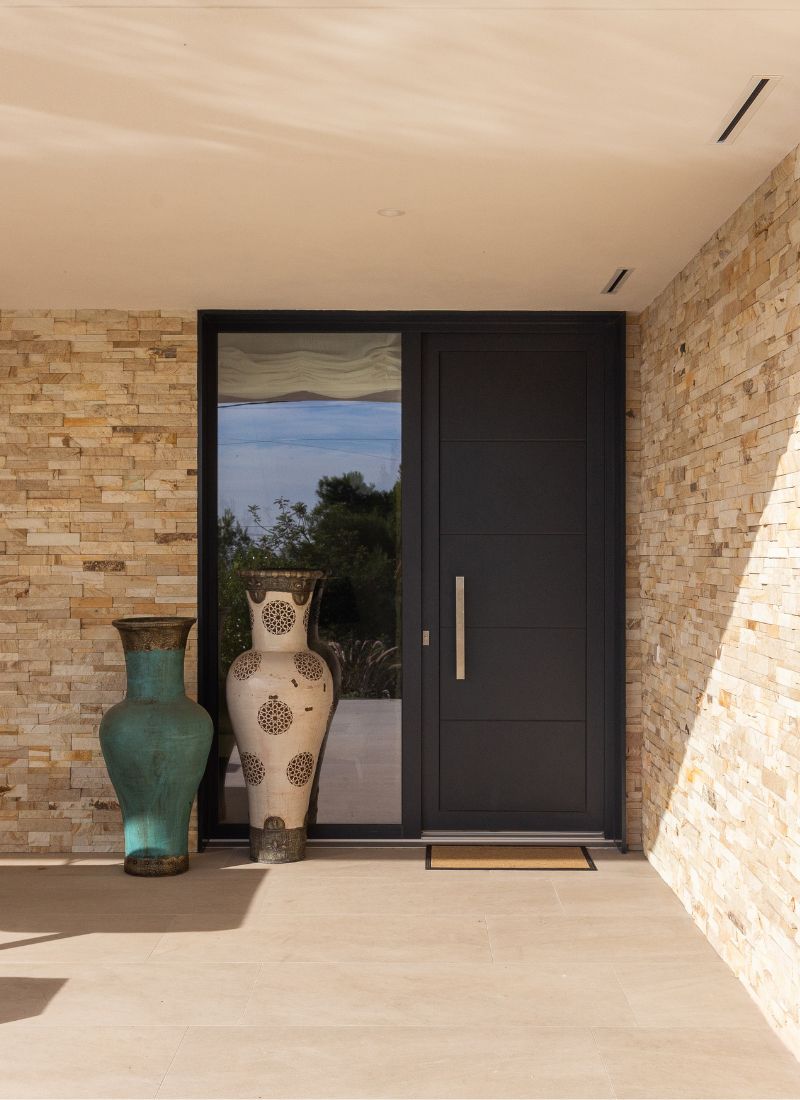Uses of ceramics in industrialised construction
We tell you about the advantages and uses of ceramics in architecture and interior design.
Ceramic is a traditional material that has been used since the beginnings of architecture and interior design, being one of the sectors that has invested the most over the years in innovation to achieve greater product versatility. Thanks to the current versatility of ceramics, it is a key material in the industrialised construction sector. In our projects, it allows us to opt for a wider range of flooring, façade, tiling and interior design options. It really allows us to design. All the pieces provided by ceramics can be adapted to a wide range of finishes. From smooth, modern finishes to perfect imitations of wood or stone, the possibilities are practically endless.
Furthermore, at Casas inHAUS, ceramics is a key element in the design and finishes, allowing us to guarantee one of our added values as a company in the sector: the possibility of our houses leaving our factory 95% finished. The supply times of the sector are fast, ceramic companies have managed to adapt their supply chains to the production times of industrialised construction, which is essential to meet our production targets.


Ceramic applications in industrialised construction
Ceramics in industrialised construction is increasingly allowing for innovative applications in both interior design and architectural projects. The versatility of ceramics allows for greater flexibility in modular or prefabricated house designs, as well as greater efficiency thanks to ventilated facades. We can see the use of ceramics in a wide range of applications:
– Ventilated facades: One of the great applications of ceramics in architecture is the possibility of creating ventilated facades. Facades that improve energy efficiency and interior comfort, as they allow greater thermal and acoustic insulation. They are a great attraction for clients, as they allow the temperature of the house to be maintained throughout the year, which translates into savings in costs associated with air conditioning. In addition, these facades meet the requirements of thermal insulation and airtightness, helping to reduce the carbon footprint of the house. On the other hand, they also allow the use of ceramic materials and innovative systems to significantly increase the useful life of the modular house, placing it above the average compared to traditional houses.
– Large format and customisable ceramic floors: Ceramic tiles allow for a variety of styles and sizes, being fully customisable. They are ideal for large, open-plan spaces typical of large luxury homes, providing visual continuity, resistance to wear and tear and an aesthetic that has been carefully designed down to the last detail.
– Decorative interior cladding: Ceramic is an ideal material for interior spaces such as bathrooms and kitchens, thanks to its great resistance to humidity and its variety of styles, textures and formats. They provide a plus in design and personality in the spaces as well as a clear functionality.
– Ceramic furniture: The demand for ceramic materials in kitchen furniture such as worktops, tables and other design elements is becoming increasingly common. This material is a great ally due to its high resistance to heat and chemicals, as well as its visual elegance.
On the other hand, ceramic tile meets the needs of our construction system due to the precision of its installation. It allows impeccable and consistent finishes, as well as having been manufactured with an exhaustive control and a low environmental impact, in line with the objectives of circular economy and zero waste of Casas inHAUS.

Advantages of using ceramics in construction
The use of ceramics in architecture offers numerous advantages, thanks also to the qualities of this material, which have been adapted to the needs of the sector and the different construction systems. Some of the advantages we find are:
– High durability and resistance to extreme climatic conditions: Ceramic materials are recognised for their exceptional resistance to external factors thanks to their technical properties such as low porosity, as well as not being affected by humidity, temperature changes or UV rays. It is a perfect material for projects that seek quality and durability. This makes ceramic tiles the most demanded materials for outdoor spaces such as porches, ventilated façades or outdoor flooring.
– Easy maintenance: Thanks to the high resistance of ceramics, even outdoors, it has the ability to remain in perfect condition for decades, which translates into savings, comfort and confidence for homeowners who can enjoy a 100% reliable product over time, a safe investment both indoors and outdoors.
– Reduced energy consumption in the home: Ventilated ceramic facades used in insulated design houses improve thermal insulation and consequently reduce the energy consumption of the house once the owners live in it.
– Variety of finishes, textures and colours: One of the most important attractions of ceramics is the ability to adapt to any architectural style or design, providing different colours or tones, formats, qualities, textures and even sensations, the possibilities are endless.
– Ease of imitation of natural materials: Another of the most characteristic technical advantages of ceramics is the ability to imitate natural materials, providing a similar aesthetic but adding durability, quality and resistance, as in the case of noble materials such as wood, stone or marble.
– Visual and aesthetic continuity: Large format ceramic pieces reduce visible joints, generating continuous surfaces with a great visual impact. These large formats can be seen on walls inside homes, floors, walls, bathrooms, kitchens, etc., providing a modern design and greater amplitude to the space.
– Versatility: As time has gone by, the ceramics sector has been one of the sectors that has invested the most in innovation in order to make ceramics more versatile, and this has been the case. Thanks to this versatility we can find it in architecture, interior design projects and furniture, offering more sustainable, efficient and aesthetically impeccable products.



Use of ceramic tiles on façades
Ceramic has become one of the most prominent materials for façade cladding in industrialised construction projects, thanks to its versatility, durability and ability to combine functionality with aesthetics. One of the most outstanding uses of ceramic in façades is in ventilated façade systems, a cladding system in which ceramic pieces are fixed to a metal structure separated from the load-bearing wall of the building, creating an air chamber between the two.
The ceramic protects the main structure from direct exposure to the weather, prolonging its useful life, as well as creating an air chamber that offers benefits in terms of insulation and energy performance.
We can highlight some advantages in terms of aesthetic and technical performance of ceramics in façades:
– Resistance to the climate of the area: The ceramics used in façades withstand adverse weather conditions, rain, wind, strong changes in temperature, etc. without losing their properties or damaging their appearance. They prevent water absorption, protecting against damp on the façade and the low porosity of the material avoids any accumulation of dirt and facilitates cleaning.
– Safety and protection in façades: The ceramic used in façades not only provides aesthetic value, but also protection and safety against fire, as it is a fireproof material, the safety of the building increases considerably. In addition, ceramic facades maintain their integrity against mechanical stresses or structural movements. This allows Casas inHAUS to transport the modules with ceramic cladding on the finished facades in complete safety and to withstand the transport from the factory to the customer’s site without damage.
– Innovation and energy efficiency: The thermal optimisation of the façade thanks to the use of ceramics avoids overheating in summer and improves the indoor climate in winter, reducing the consumption of air-conditioned systems and saving money in the future.
– Variety of finishes: Ceramic is also an ideal choice for projects that seek to stand out for their design, with it you can create natural textures imitating materials such as stone, metal or wood that resist on the facades, and smooth and minimalist surfaces ideal for projecting clean lines and a modern aesthetic on the facade.
– Architectural flexibility: Ceramic is flexible in its use and adapts to different architectural typologies, from residential buildings to commercial projects and offices, its versatility in design, formats and resistance makes it a perfect option for any type of construction.



How to use ceramics in interior design?
Ceramic is an essential material in modern interior design, with numerous applications and trends to highlight. One of its most popular applications is ceramic flooring with high resistance to heavy traffic. Ceramic is also compatible with underfloor heating systems, offering greater comfort in every home. Large formats with minimal joints are often used for ceramic floors in designer homes to create open, visually larger spaces.
Ceramic wall coverings are another outstanding option, especially in spaces such as bathrooms and kitchens. Their resistance to humidity and ease of cleaning make ceramic tiles a practical and durable choice. In addition, ceramic tiles protect walls from stains and splashes, adding a decorative touch. For those seeking a touch of superior design, there is a clear trend towards walls with textures or three-dimensional patterns.
On the other hand, ceramics are also present in furniture and decoration, thanks to its multiple finishes that allow the creation of personalised pieces adapted to the style of the space and person. Ceramic finishes can frame mirrors, windows or architectural elements, creating an elegant and cohesive visual effect.
We can also highlight some trends in the use of ceramics in interior design that stand out for their focus on design and sustainability:
– Biophilic design: an interior design that revolves around nature with the presence of exterior elements such as stones, vegetation, etc. for example in private interior courtyards. Ceramic tiles imitating natural materials such as wood or stone connect the interior spaces with nature, making this type of design possible in many homes.
– Continuous surfaces, thanks to the versatility of formats provided by ceramics.
– Neutral colours, contrasts and minimalism: Shades such as beige, grey and white together with soft textures are a trend, which ceramics manage to adapt to and provide different textures without losing their technical advantages. In contrast to minimalism, some ceramic designs opt for geometric patterns and vibrant colours to add even more personality to spaces.



Contact us
Whether you are an individual or a professional, do not hesitate to contact us for further information, to request a personalised quote or to make any enquiry.
Contact form
Consult models and prices
In our Catalogue 111 you have more than a hundred models of houses to choose from. Register to access information and prices of all models.
